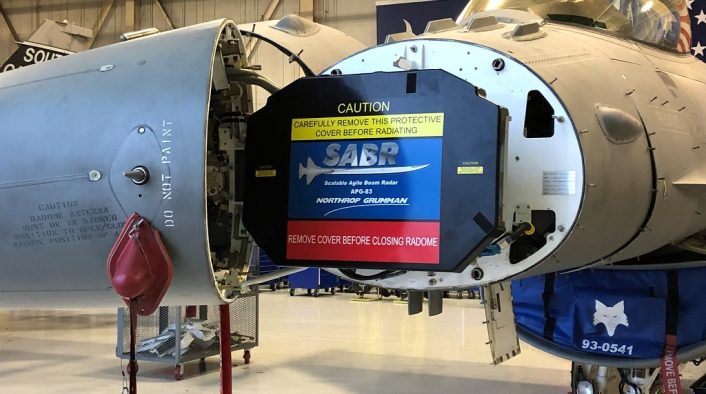The new radars were also employed recently in a cruise missile defense exercise.
Northrop Grumman announced that its AN/APG-83 SABR (Scalable Agile Beam Radar) Active Electronically Scanned Array (AESA) radar has reached the Full Operational Capability (FOC) on the U.S. Air Force Air National Guard F-16s. The fielding of the new radar began in January 2020, following a U.S. Northern Command Joint Emergent Operational Need (JEON) for homeland defense.
The JEON resulted in a first contract in 2017 for 72 SABR radars and another one this year for 15 Engineering, Manufacturing and Development (EMD) and 90 production radars. Up to 372 radars could be procured by 2027 if all options are exercised. Currently the District of Columbia ANG (Joint Base Andrews), South Carolina ANG (McEntire JNGB) and another unspecified base completed the radar upgrade, while South Dakota ANG (Joe Foss Field, Sioux Falls) started the upgrade in September.
“SABR enables F-16 pilots to detect, track, identify and target a greater number of threats faster and at longer ranges from outside the threat envelope. This upgrade will keep the multirole F-16 fighter relevant and capable for decades to come,” said Mark Rossi, director of SABR programs at Northrop Grumman.
The District of Columbia ANG employed the new radar during Guardian Shield 20-02 from September 21 to 25, which has been defined the largest live-fly cruise missile defense exercise ever held by the Department of Defense.
The exercise took place at multiple locations including Joint Base Andrews and Naval Air Station Patuxent River (Maryland) and NASA’s Wallops Flight Facility (Virginia), testing cruise missile defense tactics, techniques and procedures (TTPs) designed to meet the NORTHCOM mission of deterring, detecting and defeating threats to the United States.
According to the press release, more than 50 aircraft from Air Force active duty and Air National Guard units participated in the large-scale exercise across 40,000 nautical square miles of airspace, with F-16 Fighting Falcons, F-15 Eagles and F-22 Raptors being the defenders and T-38 Talons and L-159 Honey Badgers simulating up to 80 cruise missiles per two-hour vulnerability period, or the time aircraft are away from base in their area of operations and vulnerable to harm.

The scenario involved the simulated defense of Wallops Island from an adversary cruise missile attack using fighter aircraft. Each day, the scenario was made more difficult in order to validate TTPs against current threats while also building tactics to address emerging adversary capabilities. Another key point of the exercise was to test agile combat employment concepts, with NASA’s Wallops Flight Facility serving as a simulated austere environment where the DCANG sent maintenance personnel to rapidly rearm and refuel aircraft and send them back in action.
Guardian Shield 20-02 was the first exercise where the DCANG used the APG-83 and because of that, it was used to showcase the new capabilities and to test and refine the TTPs being developed for the new radar. “Normally, new technology is tested and tactics manuals written prior to being fielded to operational units. This is unique because the fielding, testing and development is happening at the same time,” said Lt. Col. Christopher Wilson, commander of the 121st Fighter Squadron, 113th Wing, DCANG.
The radar upgrade of Air National Guard F-16s extends the operational viability and reliability of the fleet while providing pilots with 5th-generation fighter radar capabilities similar to F-22s and F-35s, improving existing air-to-air capabilities and enhancing air-to-ground mapping with a high-resolution synthetic aperture radar function. The SCANG’s F-16s Block 52 will use the APG-83 also for Suppression or Destruction of Enemy Air Defenses (SEAD/DEAD), to include targeting radars and surface-air-missiles.
While the radar is being fielded, operational testing is continuing at Eglin Air Force Base (Florida). This summer the Operational Flight Program Combined Test Force performed for the first time a four-ship (the basic fighting formation for fighter aircraft) flight test mission with APG-83-equipped F-16s to assess the behaviour of the radar during this type of scenarios, with four aircraft in close proximity, and to verify if the four radars interfere with each other, degrading he signal, or if they work better, improving the signal.
Speaking of Eglin AFB and cruise missile defense, in December 2019 an OT F-16C shot down a subscale drone, simulating a cruise missile’s flight profile, using an AGR-20A Advanced Precision Kill Weapon System (APKWS) laser-guided rocket, providing a proof of concept for using rockets lased by a Sniper or Litening targeting pod as viable munitions to perform cruise missile defense.
The APKWS was developed as a low cost, low collateral damage air-to-ground weapon for Close Air Support (CAS) missions and the test demonstrated that it can be used efficiently in the counter-air role at a fraction of the cost of the AIM-120 AMRAAM commonly used for cruise missile defense, while also allowing faster rearming and increased number of weapons on board. The F-16 can in fact carry up to six AIM-120s, while a single LAU-131A/A pod carries seven rockets and up to four pods can be carried by an F-16 in standard configuration, for a total of 28 APKWS rockets.









